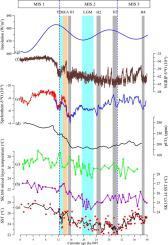Journal of Asian Earth Sciences ( IF 2.7 ) Pub Date : 2021-06-10 , DOI: 10.1016/j.jseaes.2021.104862 Shengfa Liu , Kaikai Wu , Jingrui Li , Hui Zhang , Peng Cao , Xiaoyan Li , Hui-Juan Pan , Somkiat Khokiattiwong , Narumol Kornkanitnan , Xuefa Shi

|
To better understand the process of hydrographic and temperature changes in the Indian Ocean, we present Glycerol dialkyl glycerol tetraether data on core BoB-56 from the Bay of Bengal to reconstruct the sea surface temperature (SST) variability during the last glaciation. The results indicate that the TEX86-derived SST ranged from 22.00 to 28.30 °C with several fluctuations since 40 ka BP and that the evolution pattern matched well with the marine isotope stage (MIS). During MIS 3, the SST kept around 24.60 °C with some small amplitudes. The SST showed more significant fluctuations during MIS 2 and increased gradually with a ~3 °C cooling during the Last Glacial Maximum (LGM). After the Younger Dryas (YD) stage, Holocene SST values exhibited miniscule variations. During the last glaciation climate variability process, the cold signals of the YD and Heinrich events were recorded well in our core SST series, revealing a regional response to global climate changes. The warming trend during these millennial-scale cold events in the northern Indian Ocean was also identified, and SST increased in the range of 2 °C. A comparison of SST records and atmospheric CO2 concentration shows that the warming process during the YD, LGM, and Heinrich (1–4) events matched the gradual increase in atmospheric CO2 concentration in the northern Indian Ocean. Hence, this study implies millennial-scale hydroclimate change linked with atmospheric CO2 forcing that could improve our knowledge of the role of atmospheric CO2 in triggering abrupt Indian Ocean climate changes.
中文翻译:

北印度洋千年尺度寒冷事件期间的变暖趋势和过去 40 kyr 期间潜在的大气 CO 2强迫
为了更好地了解印度洋的水文和温度变化过程,我们提供了孟加拉湾 BoB-56 岩心的甘油二烷基甘油四醚数据,以重建上次冰期期间的海面温度 (SST) 变化。结果表明 TEX 86衍生的 SST 范围从 22.00 到 28.30 °C,自 40 ka BP 以来有几次波动,并且演化模式与海洋同位素阶段 (MIS) 匹配良好。在 MIS 3 期间,SST 保持在 24.60 °C 左右,并具有一些小幅度。SST 在 MIS 2 期间表现出更显着的波动,并在末次盛冰期 (LGM) 期间随着~3°C 的冷却逐渐增加。在新仙女木 (YD) 阶段之后,全新世 SST 值表现出微小的变化。在末次冰期气候变化过程中,我们的核心海温系列很好地记录了YD和Heinrich事件的冷信号,揭示了对全球气候变化的区域响应。还确定了北印度洋这些千年尺度寒冷事件期间的变暖趋势,海温增加了 2°C。2浓度表明,YD、LGM 和 Heinrich (1-4) 事件期间的变暖过程与北印度洋大气 CO 2浓度的逐渐增加相匹配。因此,这项研究意味着千禧年尺度的水文气候变化与大气 CO 2强迫有关,这可以提高我们对大气 CO 2在触发印度洋气候突然变化中的作用的认识。











































 京公网安备 11010802027423号
京公网安备 11010802027423号